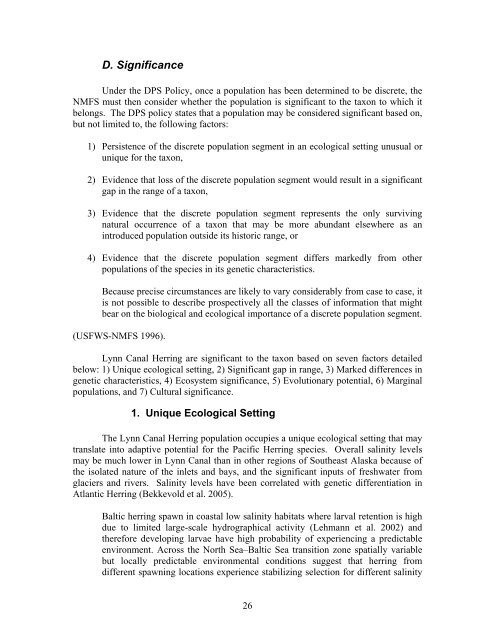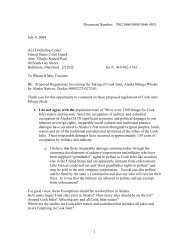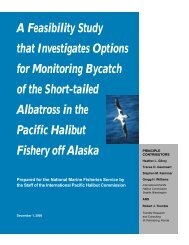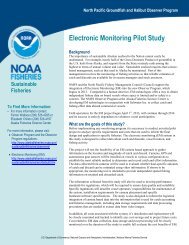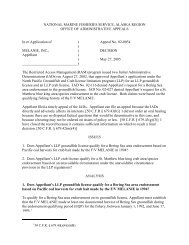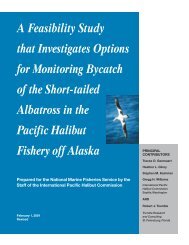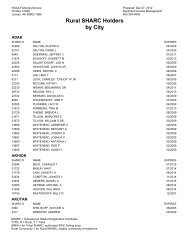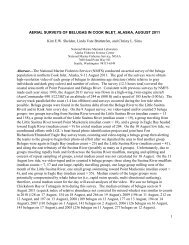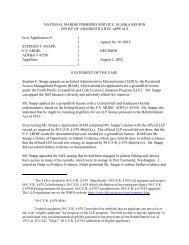Petition to List Lynn Canal Pacific Herring under the Endangered ...
Petition to List Lynn Canal Pacific Herring under the Endangered ...
Petition to List Lynn Canal Pacific Herring under the Endangered ...
Create successful ePaper yourself
Turn your PDF publications into a flip-book with our unique Google optimized e-Paper software.
D. Significance<br />
Under <strong>the</strong> DPS Policy, once a population has been determined <strong>to</strong> be discrete, <strong>the</strong><br />
NMFS must <strong>the</strong>n consider whe<strong>the</strong>r <strong>the</strong> population is significant <strong>to</strong> <strong>the</strong> taxon <strong>to</strong> which it<br />
belongs. The DPS policy states that a population may be considered significant based on,<br />
but not limited <strong>to</strong>, <strong>the</strong> following fac<strong>to</strong>rs:<br />
1) Persistence of <strong>the</strong> discrete population segment in an ecological setting unusual or<br />
unique for <strong>the</strong> taxon,<br />
2) Evidence that loss of <strong>the</strong> discrete population segment would result in a significant<br />
gap in <strong>the</strong> range of a taxon,<br />
3) Evidence that <strong>the</strong> discrete population segment represents <strong>the</strong> only surviving<br />
natural occurrence of a taxon that may be more abundant elsewhere as an<br />
introduced population outside its his<strong>to</strong>ric range, or<br />
4) Evidence that <strong>the</strong> discrete population segment differs markedly from o<strong>the</strong>r<br />
populations of <strong>the</strong> species in its genetic characteristics.<br />
Because precise circumstances are likely <strong>to</strong> vary considerably from case <strong>to</strong> case, it<br />
is not possible <strong>to</strong> describe prospectively all <strong>the</strong> classes of information that might<br />
bear on <strong>the</strong> biological and ecological importance of a discrete population segment.<br />
(USFWS-NMFS 1996).<br />
<strong>Lynn</strong> <strong>Canal</strong> <strong>Herring</strong> are significant <strong>to</strong> <strong>the</strong> taxon based on seven fac<strong>to</strong>rs detailed<br />
below: 1) Unique ecological setting, 2) Significant gap in range, 3) Marked differences in<br />
genetic characteristics, 4) Ecosystem significance, 5) Evolutionary potential, 6) Marginal<br />
populations, and 7) Cultural significance.<br />
1. Unique Ecological Setting<br />
The <strong>Lynn</strong> <strong>Canal</strong> <strong>Herring</strong> population occupies a unique ecological setting that may<br />
translate in<strong>to</strong> adaptive potential for <strong>the</strong> <strong>Pacific</strong> <strong>Herring</strong> species. Overall salinity levels<br />
may be much lower in <strong>Lynn</strong> <strong>Canal</strong> than in o<strong>the</strong>r regions of Sou<strong>the</strong>ast Alaska because of<br />
<strong>the</strong> isolated nature of <strong>the</strong> inlets and bays, and <strong>the</strong> significant inputs of freshwater from<br />
glaciers and rivers. Salinity levels have been correlated with genetic differentiation in<br />
Atlantic <strong>Herring</strong> (Bekkevold et al. 2005).<br />
Baltic herring spawn in coastal low salinity habitats where larval retention is high<br />
due <strong>to</strong> limited large-scale hydrographical activity (Lehmann et al. 2002) and<br />
<strong>the</strong>refore developing larvae have high probability of experiencing a predictable<br />
environment. Across <strong>the</strong> North Sea–Baltic Sea transition zone spatially variable<br />
but locally predictable environmental conditions suggest that herring from<br />
different spawning locations experience stabilizing selection for different salinity<br />
26


